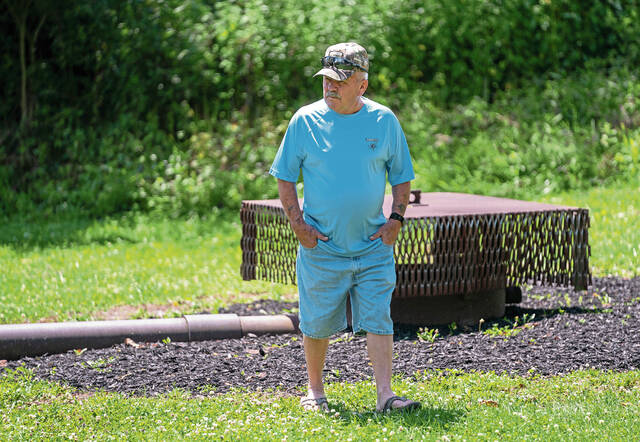https://development.triblive.com/local/regional/that-was-my-last-day-quecreek-miner-says-of-rescue-date-after-30-year-career/
'That was my last day,' Quecreek miner says of rescue date after 30-year career

Ron Hileman’s last day underground as a coal miner was July 28, 2002.
Being trapped 240 feet below the surface in Quecreek Mine for 77 hours with eight other miners was enough to make him retire.
“That was my last day,” he said.
Hileman, 69, of Gray, had spent almost 30 years working underground as a roof bolter. On July 24, 2002, his crew, relying on outdated mine maps, mistakenly bored through an abandoned section of a neighboring mine in Somerset County. That unleashed millions of gallons of frigid water and blocked their exit, prompting a dramatic rescue watched by millions around the world.
It had been a lucrative job.
“Back in ’74, then there wasn’t too many jobs that paid what a coal miner made,” he said.
On Friday morning, Hileman and three of his fellow rescued miners visited the Lincoln Township site where they returned to the surface 20 years ago through a yellow metal capsule.
Dozens of those who were involved with the rescue, or who now work with agencies that had a role, gathered at the memorial and education center built in the years afterward to recount the collaboration among state, federal and local agencies, as well as the local residents and drillers.
“We have a unique bond that comes of this kind of life-and-death challenge that most people do not face,” former Gov. Mark Schweiker said.
Twenty years’ worth of thanks were expressed by several involved in the rescue during a briefing at the education center. The rescued miners were Hileman, Blaine Mayhugh, Mark Popernack, John Phillippi, Randy Fogle, Tom Foy, John Unger, Robert Pugh and Dennis Hall, who died May 13.
Foy, who is retired, took a moment alone at the rescue site under a hot sun Friday looking at the spot where the shaft was drilled for the capsule and a second place nearby that was used to pump fresh air into the area where the miners were trapped.
Unger, 72, fell into a career as a coal miner. Jobs for $50 a day in 1974 seemed like a good way to earn the $5,000 he was saving for a down payment to build a house.
“I was only going to do it for five years,” he said.
The house in Conemaugh Township was built, but Unger didn’t give up the job.
“Well then, the money got better and better,” he said. “And I didn’t mind the work. The money got really pretty good for back then.”
His mother called him a “workaholic” in an interview with the Associated Press while families were waiting for the men to be rescued.
“I loved being a miner,” he said. “I liked that. It was a good job.”
He is now retired and maintains a cattle farm.
For Pugh, 70, of Quemahoning, coal mining was built into his DNA, though he wasn’t fond of the job. He started working underground on Nov. 17, 1970, after graduating from high school. Several family members were coal miners.
Thinking about the more dangerous work would keep him up at night, sometimes leaving him dreading his shift the next day.
“We’re like a cat with nine lives,” he said. “Down there, I should’ve been killed a couple times.”
He also is retired and has a goat and chicken farm. The mine closed for good in 2018.
The nine-man crew had been working together for a few years, and their teamwork helped keep the group positive during the dayslong ordeal, Hileman said.
“We all had years, we weren’t new coal miners,” he said. “We never expected anything like that. I thought there was a rock somewhere with my name on it.”
Related• 'A complete miracle': The 20th anniversary of the Quecreek Mine rescue • Quecreek timeline • How rescuers saved the trapped Quecreek miners
Copyright ©2025— Trib Total Media, LLC (TribLIVE.com)
